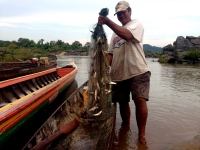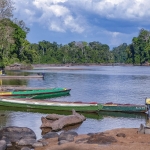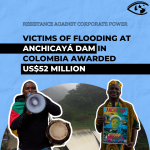Mega First of Malaysia Under Fire for Lao Dam Construction Plan

Plans for the Don Sahong dam in southern Laos have come under renewed fire from environmental activists. This week activists boycotted a regional consultation on the dam, just eight weeks after filing a formal request for an investigation of Mega First Corporation, the company that has the construction contract.
"In short, people do not want the dam to exist," Duong Pov, deputy governor of Cambodia's Stung Treng district, told Voice of America Khmer this week. "If built, it will affect us. Once it exists, the solutions would be complicated. We do not know what to do to prevent it from happening."
A total of about a dozen dams are planned for the Mekong River, which extends some 4,000 kilometres (2,500 miles) from China into Burma and then winds its way through Cambodia, Laos, Thailand and Vietnam. Laos is particularly keen on these projects in order to generate electricity for export to Thailand, which they hope will become a major source of foreign currency for the landlocked country which has very little international trade.
The proposed 30 meter high Don Sahong dam is to be situated in Champasak Province, Laos, very close to the Cambodia border. The contract to build the 260 megawatt project was awarded in 2008 to Mega First Corporation Berhad, an a construction company, based in Petaling Jaya, Malaysia. The company is controlled by the family of Goh Nan Kioh, who also happens to have a 50 percent share in Cambrew, manufacturers of Angkor beer, the most popular beer in Cambodia.
On October 20, six environmental non-profits from Cambodia, Thailand and the United States filed a formal complaint against Mega First Corporation Berhad. The groups asked Suhakam, the Malaysian human rights commission, to investigate Mega First's plans for the dam which is to block the Mekong River.
The request was the first time that Suhakam has been asked to investigate a project in another country.
The activists say that the dam will block the main year-round channel that fish use to migrate between Cambodia, Laos and Thailand, harming fish stocks and commercial fisheries, on a river that ranks second in the world for fish diversity after the Amazon.
Ian Baird, a professor of geography at the University of Wisconsin-Madison who studied the impact of the Don Sahong dam in 2009, concluded that the dam's impact on migratory fish would be certain and irreversible. In addition, the endangered Irrawaddy dolphin - only 85 are believed to be left - would likely go extinct if the dam is built, say experts.
In the petition, the activists also stated that Mega First's proposal is "contrary to accepted principles of international law including the duty to consult with and inform affected communities, the duty to adequately investigate likely significant harms, and the duty to mitigate the harmful consequences of development projects."
"Most of my people fish as a way of life. It is how they feed their families and earn a living," Huot Seng, the chief of Loe village, told reporters after the request was filed. "But when the company comes to build the Don Sahong [p]roject, they never ask about the fish. They just tell me there will be no problem."
Yeong Chee Neng, Mega First's director for the Don Sahong project, says that the project will help the local community. "It will be better because the dam will make it possible for more fish to swim up and down, and that has been proven by our consultants and experts. . . If we wouldn't know what we are doing, we wouldn't do it. We wouldn't do anything that is not good for the people."
The activists ridiculed Yeong. "How can their argument be that? That the fish can move and migrate through these bypasses?" Chhith Sam Ath, executive director of NGO Forum in Phnom Penh, asked the Cambodia Daily. "Do they have traffic lights for fish so that they can go through the bypasses?"
Earth Rights International, a Thai NGO, notes that the company has not conducted any transboundary impact assessments. And Yeong has refused to provide Cambodia newspapers with copies of the environmental impact assessments of the dam, saying that it was up to the discretion of the Laos government to release it.
A regional consultation on the dam was scheduled for December 12, but none of the activist groups attended. "The Lao government has clearly stated they intend to proceed with the Don Sahong dam, in spite of the ongoing prior consultation process," Ame Trandem, southeast Asia programme director for International.Rivers, told the Bangkok Post. "With this attitude, it is difficult to see how the process can be anything more than a rubber stamp."
- 183 Environment



